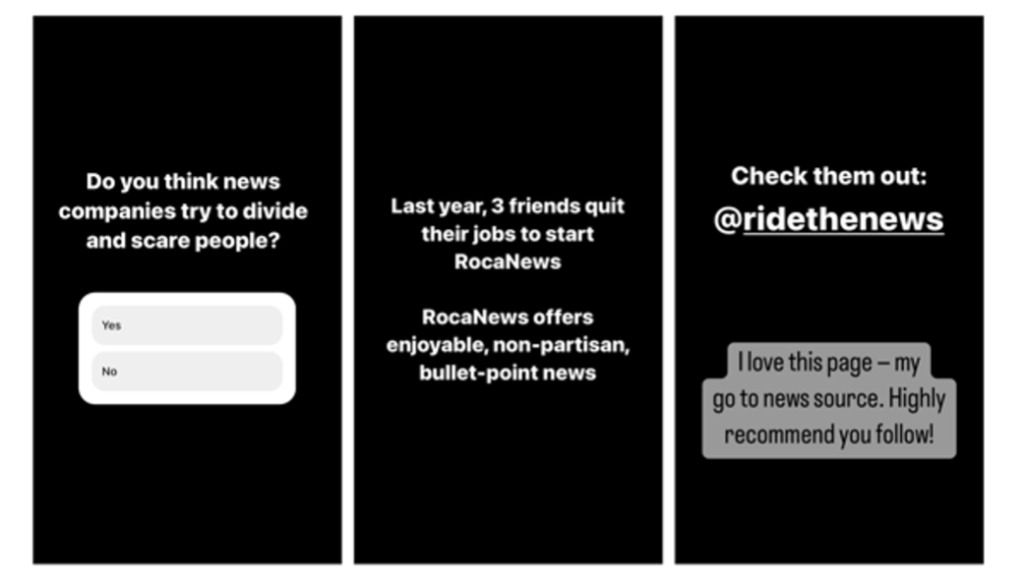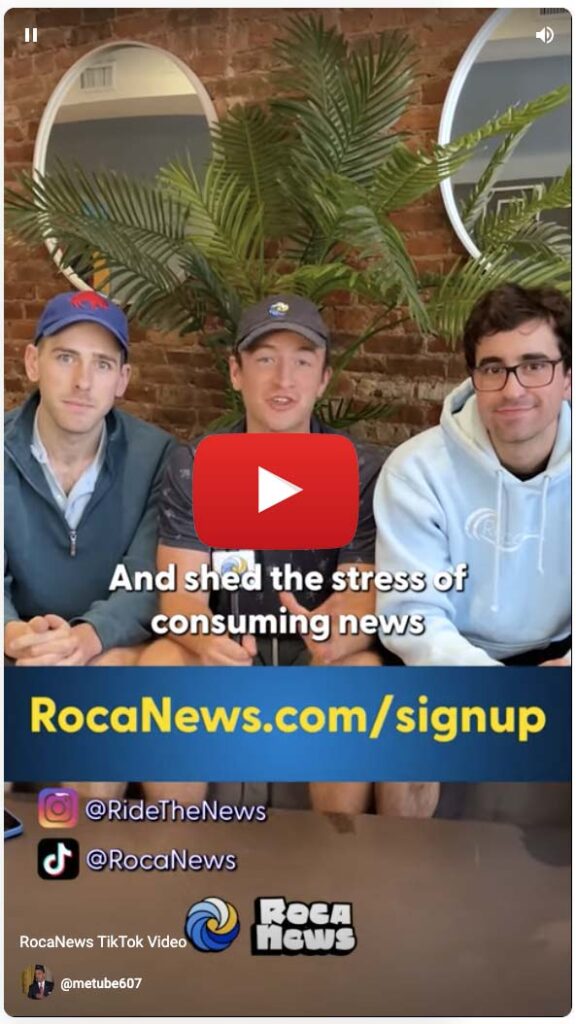The Future Of News
And what it means for your startup
While watching too much TV during the 2020 Covid lockdowns, Max Frost, Max Towey, and Billy Carney became frustrated with mainstream news as biased and out of touch. So they launched RocaNews, an Instagram-centric news outlet, in August of that year. Now they have over 1.2m followers on Instagram, a quarter million subscribers to their newsletter, and an app that’s had off-the-charts engagement in beta.
This is a story about the future of news. But the RocaNews journey—particularly how they talk about their mission to gain subscribers—also contains valuable storytelling lessons for all entrepreneurs.
It’s not hard to find problems with today’s news options. As Max Frost and his co-founder Billy see it, the false attempt at impartiality is part of the problem. “If you never use ‘I’ and pretend you don’t exist, people are skeptical of that,” Max says.
Presenting a news organization as a monolithic entity projects impartiality, like cloaking judges in black robes, but the benefit is brittle. In this social media era, any perceived bias is easy to amplify, and an institution has few tools to rebuild fraying confidence.
I was a mainstream news journalist for years—and my instinct is to bristle at the idea that I was, as an extension of the charges against the outlets I worked for, aloof, condescending, and partisan. But no matter the opinions, the facts are clear: mainstream news has abandoned vast demographic territory, a void that has been eagerly filled with influencers of dubious trustworthiness shouting at each other on social media. The three biggest TV news outlets—CNN, MSNBC, and Fox News—averaged about 360k viewers combined in the 25-54 demographic during primetime last month. That’s less than half a percent of the 100m Americans in that age bracket.
At launch in August 2020, the Roca founders tried a bunch of different channels and approaches to promote their fledgling news outlet. Nothing really stuck. By early 2021 they noticed that Instagram and a newsletter was performing slightly better than other channels, so they focused on those. They garnered a few hundred followers over the coming months. Their coverage of the GameStop fiasco was their first break, enabling them to crack 1,000 followers.
They kept tinkering with the story formats and visuals, and tried “a million ways” to advertise, Billy says. Finally, they figured it out. Here’s the folksy three-slide Instagram beachhead that allowed them to storm their continent of opportunity. It looks like it was put together in about five minutes, but it took months to get it this simple:

Two years on, these three panels still reliably bring in followers at substantially lower costs than industry benchmarks.
Distilling their pitch down to those 46 words is an achievement—and should inspire all founders to look for ways to both simplify and personalize their pitch. (RocaNews won an Otto Award in 2022 for this campaign.)
RocaNews reporting is simple, bullet-pointed, and visually fits in with your Instagram feed. It’s not targeted at high-information news consumers, but at the vast tracts of people who don’t pay much attention to current events. That’s why you won’t find, for example, an article that describes an ethnic conflict in a far-away land. That might be a staple in an outlet like The New York Times, but RocaNews readers might not know anything about the country. Instead, RocaNews has found success with features from countries like Ethiopia by focusing on first-person reporting that works to eliminate the barrier between writer and reader.
In other words: Reach your audience where they are, not where you think they should be.
Articles such as this one are filled with the personal experiences of the writer. What they ate, where they stayed, what the land looks like. “Journalists keep the best parts of the story to themselves,” Max F. says, when they strip out everything that you’d likely ask that journalist if you met them for a beer. “This is the stuff that gets people to care. They’re withheld from the reader for purposes of objectivity,” he says, “but that’s what gets people to care. How can you trust the writer if you don’t feel you have a relationship with them?”
That’s a sentiment that might make a traditional journalist shiver, but it’s proven true time and time again across all kinds of industries. Think about how much we often want our businesses to look bigger than it is. I remember ages ago setting up an automated phone answering service with a “Press 1 for sales, Press 2 for support, Press 3 for…” menu, where all the extensions rang at my desk. These days we hide behind stock photos, generic About statements, and info@ email addresses. But the magic comes from projecting personalization. Scale and personalization can co-exist.
Think of what this means in your vertical. Sure, there are incumbents with armies of staff and billions of dollars, but they can’t plausibly create a video like this one that RocaNews produced for TikTok:
Roca took the “man of the people” idea one step further last fall when they offered to donate $1,000 to people in need if their newsletter readers referred 1,000 new signups. It took an hour. “That evening we went to a poor neighborhood in Manhattan and went to a supermarket and handed out $1000 in cash to people there,” Max says.
That yielded such great video footage that they named their initiative Grow for Good and expanded. They offered to give away $10,000 with the next 10,000 followers, which they got by the next day. “We they drove out to small towns in Pennsylvania, contacted a church that had people who had fallen on hard times and gave them money,” Max remembers. “We would go up to people and pay for their groceries. It turns out $10,000 takes a long time to give away. We drove around tipping the gas station attendants $100. Any day we can support a community instead of Meta or ByteDance, that’s a good day.”
By the end of the 3-day promotion, their newsletter had 30,000 new readers—their fastest subscriber growth ever.
The news business is more fraught with charges of bias than most industries, not least because people tend to view their political opinions not only as right, but as objectively correct. But the trail RocaNews is blazing is valuable no matter what business you’re in.
“People want a sense of accountability,” Billy says. “With us, you know who is at the top of the organization. It’s Max, Max, and Billy.”
Key Takeaways:
- Personalize & humanize your company image
- Test your message and simplify as much as possible
- Meet your audience where they are


